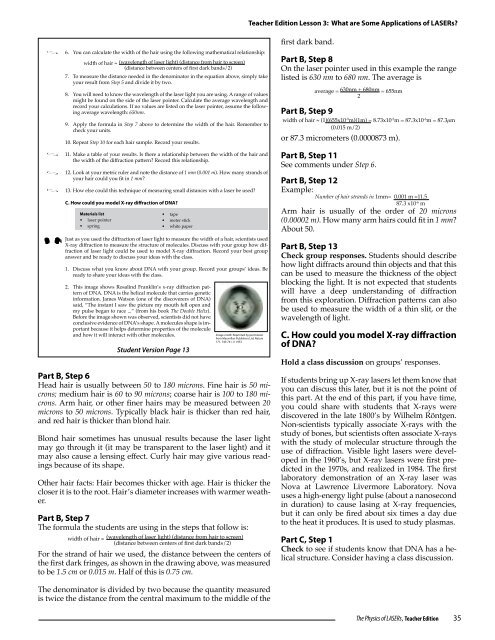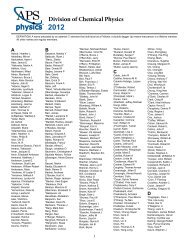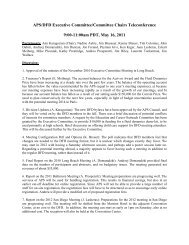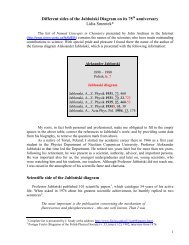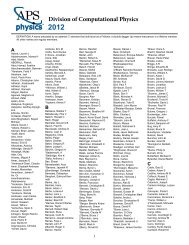The Physics of LASERs - American Physical Society
The Physics of LASERs - American Physical Society
The Physics of LASERs - American Physical Society
Create successful ePaper yourself
Turn your PDF publications into a flip-book with our unique Google optimized e-Paper software.
Student Edition Lesson 3: What are Some Applications <strong>of</strong> LASERS?<br />
14<br />
6. You can calculate the width <strong>of</strong> the hair using the following mathematical relationship:<br />
width <strong>of</strong> hair ≈ (wavelength <strong>of</strong> laser light) (distance from hair to screen)<br />
(distance between centers <strong>of</strong> first dark bands/2)<br />
7. To measure the distance needed in the denominator in the equation above, simply take<br />
your result from Step 5 and divide it by two.<br />
8. You will need to know the wavelength <strong>of</strong> the laser light you are using. A range <strong>of</strong> values<br />
might be found on the side <strong>of</strong> the laser pointer. Calculate the average wavelength and<br />
record your calculations. If no values are listed on the laser pointer, assume the following<br />
average wavelength: 650nm.<br />
9. Apply the formula in Step 7 above to determine the width <strong>of</strong> the hair. Remember to<br />
check your units.<br />
10. Repeat Step 10 for each hair sample. Record your results.<br />
11. Make a table <strong>of</strong> your results. Is there a relationship between the width <strong>of</strong> the hair and<br />
the width <strong>of</strong> the diffraction pattern? Record this relationship.<br />
12. Look at your metric ruler and note the distance <strong>of</strong> 1 mm (0.001 m). How many strands <strong>of</strong><br />
your hair could you fit in 1 mm?<br />
13. How else could this technique <strong>of</strong> measuring small distances with a laser be used?<br />
C. How could you model X-ray diffraction <strong>of</strong> DNA?<br />
<strong>The</strong> <strong>Physics</strong> <strong>of</strong> <strong>LASERs</strong><br />
Materials list<br />
• laser pointer<br />
• spring<br />
Part B, Step 6<br />
Head hair is usually between 50 to 180 microns. Fine hair is 50 microns;<br />
medium hair is 60 to 90 microns; coarse hair is 100 to 180 microns.<br />
Arm hair, or other finer hairs may be measured between 20<br />
microns to 50 microns. Typically black hair is thicker than red hair,<br />
and red hair is thicker than blond hair.<br />
Blond hair sometimes has unusual results because the laser light<br />
may go through it (it may be transparent to the laser light) and it<br />
may also cause a lensing effect. Curly hair may give various readings<br />
because <strong>of</strong> its shape.<br />
Other hair facts: Hair becomes thicker with age. Hair is thicker the<br />
closer it is to the root. Hair’s diameter increases with warmer weather.<br />
Part B, Step 7<br />
<strong>The</strong> formula the students are using in the steps that follow is:<br />
width <strong>of</strong> hair ≈<br />
• tape<br />
• meter stick<br />
• white paper<br />
Just as you used the diffraction <strong>of</strong> laser light to measure the width <strong>of</strong> a hair, scientists used<br />
X-ray diffraction to measure the structure <strong>of</strong> molecules. Discuss with your group how diffraction<br />
<strong>of</strong> laser light could be used to model X-ray diffraction. Record your best group<br />
answer and be ready to discuss your ideas with the class.<br />
1. Discuss what you know about DNA with your group. Record your groups’ ideas. Be<br />
ready to share your ideas with the class.<br />
2. This image shows Rosalind Franklin’s x-ray diffraction pattern<br />
<strong>of</strong> DNA. DNA is the helical molecule that carries genetic<br />
information. James Watson (one <strong>of</strong> the discoverers <strong>of</strong> DNA)<br />
said, “<strong>The</strong> instant I saw the picture my mouth fell open and<br />
my pulse began to race ...“ (from his book <strong>The</strong> Double Helix).<br />
Before the image shown was observed, scientists did not have<br />
conclusive evidence <strong>of</strong> DNA’s shape. A molecules shape is important<br />
because it helps determine properties <strong>of</strong> the molecule<br />
and how it will interact with other molecules.<br />
Student Version Page 13<br />
Image credit: Reprinted by permission<br />
from Macmillan Publishers Ltd: Nature<br />
171, 740-741, © 1953<br />
(wavelength <strong>of</strong> laser light) (distance from hair to screen)<br />
(distance between centers <strong>of</strong> first dark bands/2)<br />
For the strand <strong>of</strong> hair we used, the distance between the centers <strong>of</strong><br />
the first dark fringes, as shown in the drawing above, was measured<br />
to be 1.5 cm or 0.015 m. Half <strong>of</strong> this is 0.75 cm.<br />
<strong>The</strong> denominator is divided by two because the quantity measured<br />
is twice the distance from the central maximum to the middle <strong>of</strong> the<br />
Teacher Edition Lesson 3: What are Some Applications <strong>of</strong> <strong>LASERs</strong>?<br />
first dark band.<br />
Part B, Step 8<br />
On the laser pointer used in this example the range<br />
listed is 630 nm to 680 nm. <strong>The</strong> average is<br />
Part B, Step 9<br />
or 87.3 micrometers (0.0000873 m).<br />
Part B, Step 11<br />
See comments under Step 6.<br />
Part B, Step 12<br />
Example:<br />
average = 630nm + 680nm = 655nm<br />
2<br />
width <strong>of</strong> hair ≈ (1)(655x10-9m)(1m) = 8.73x10-5m = 87.3x10-6m = 87.3μm<br />
(0.015 m/2)<br />
Arm hair is usually <strong>of</strong> the order <strong>of</strong> 20 microns<br />
(0.00002 m). How many arm hairs could fit in 1 mm?<br />
About 50.<br />
Part B, Step 13<br />
Check group responses. Students should describe<br />
how light diffracts around thin objects and that this<br />
can be used to measure the thickness <strong>of</strong> the object<br />
blocking the light. It is not expected that students<br />
will have a deep understanding <strong>of</strong> diffraction<br />
from this exploration. Diffraction patterns can also<br />
be used to measure the width <strong>of</strong> a thin slit, or the<br />
wavelength <strong>of</strong> light.<br />
C. How could you model X-ray diffraction<br />
<strong>of</strong> DNA?<br />
Hold a class discussion on groups’ responses.<br />
If students bring up X-ray lasers let them know that<br />
you can discuss this later, but it is not the point <strong>of</strong><br />
this part. At the end <strong>of</strong> this part, if you have time,<br />
you could share with students that X-rays were<br />
discovered in the late 1800’s by Wilhelm Röntgen.<br />
Non-scientists typically associate X-rays with the<br />
study <strong>of</strong> bones, but scientists <strong>of</strong>ten associate X-rays<br />
with the study <strong>of</strong> molecular structure through the<br />
use <strong>of</strong> diffraction. Visible light lasers were developed<br />
in the 1960’s, but X-ray lasers were first predicted<br />
in the 1970s, and realized in 1984. <strong>The</strong> first<br />
laboratory demonstration <strong>of</strong> an X-ray laser was<br />
Nova at Lawrence Livermore Laboratory. Nova<br />
uses a high-energy light pulse (about a nanosecond<br />
in duration) to cause lasing at X-ray frequencies,<br />
but it can only be fired about six times a day due<br />
to the heat it produces. It is used to study plasmas.<br />
Part C, Step 1<br />
Check to see if students know that DNA has a helical<br />
structure. Consider having a class discussion.<br />
<strong>The</strong> <strong>Physics</strong> <strong>of</strong> <strong>LASERs</strong>, Teacher Edition<br />
35


